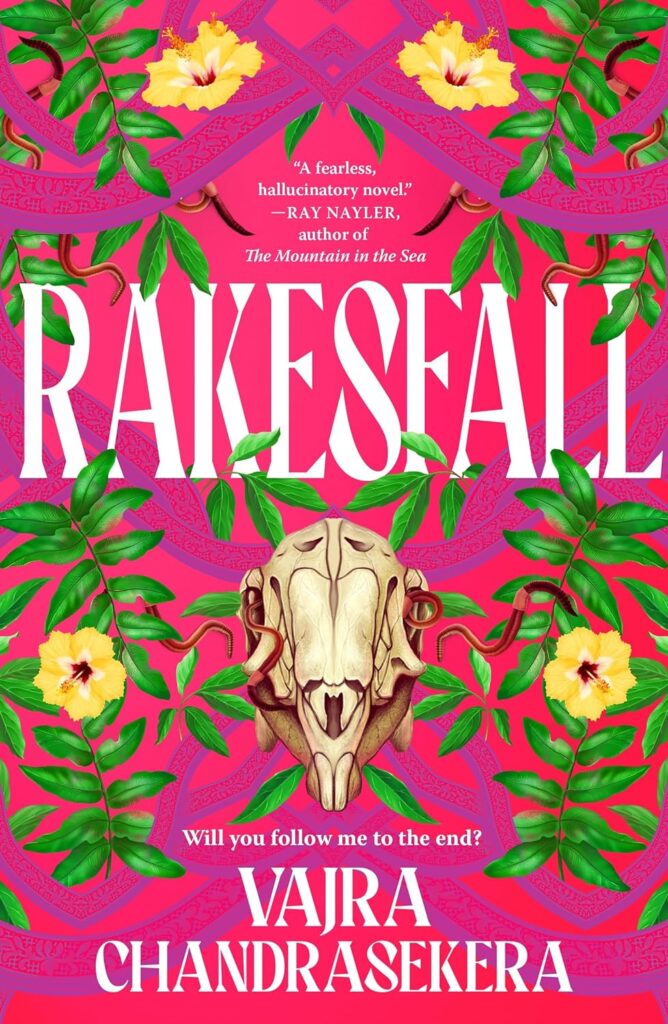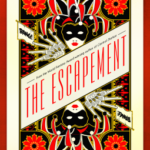Brace yourself for a wild ride through cascading realities, where the dead and living intermingle in daily life, and exploding time scales from Sri Lanka’s present and recent past to the far, far future of an earth boiling under an expanded red sun. This is the world and universe of Vajra Chandrasekera’s Rakesfall. It offers a startling contrast to the author’s award-winning The Saint of Bright Doors. The story, really a melange of stories mixing myth, history and personal memory, may be hard to follow at times, but Rakesfall is always dazzling and fearless in its scooping up of realities and turning them inside out. I was consistently pulled along by the writing even when I was completely losing track of which reality I was following.
The novel begins with chapters that were originally published as a stand-alone short story. (There are four other sections that had a similar origin, which adds to the sense of abruptly jumping from one reality or time scale to another.) Those opening chapters immediately let you know that you will be stepping through boundaries of many types. We are said to be watching a TV show that follows teenagers Annelid and Leveret. (We later find out that their real names are Vidyucchika and Lambajihva, as they recur in different forms throughout the novel.)
When not playing in the jungle, which is actually an abandoned colonial plantation, they go to school where the main assignment is to watch a TV show about those who are watching the show, the fandom. Emphasizing the fluidity of states of being, the fandom consists of those who are dead. As the narrator says, we watch them, and they watch us. And, they add, “we”, the fandom, are watching the living in a dead place “while we are the dead in a living world. We are the ones who make this a haunted world.” The dead assume many roles in this novel, and they often inhabit the world of the living, as they go to work or take their places in the homes of their still living relatives. We also learn that the TV is deeply committed to “unreal time, seeming to glide back and forth across the spans of our lives.”
That span includes the long civil war in Sri Lanka, which the teacher in the TV show explains, “is now over but never over.” The TV show (both the show fandom is watching and the show within it) is like life in that it has no episodes, names, just occasional breaks, like the flow of consciousness, yet those watching reorganize that flow with borders, breaking it into episodes and seasons.
We get drawn deeply into the reality of Annelid’s and Leveret’s lives and hear the lore and warnings of their grandparents, especially about not going into the jungle. Those watching the show point out that these are forebodings of what is about to happen when they do go there. Leveret has joined a revolutionary group and tries to persuade Annelid to join. In the midst of this conversation in the jungle, Annelid hits Leveret in the back of the head with a rock, and the show abruptly ends. The show is suddenly cancelled so we never learn if he is dead, but fandom divides into factions to explain what must have happened. Some believe the characters have been trained to emerge into the world of fandom when the show ends, others believe they have already emerged.
In the last chapter of the first section, we switch to the point of view of the body lying in the forest that has erupted into a new world but can’t tell if it’s a he or she. It settles on the idea of being we, carrying each other and taking turns being “I”. But mostly, this is she, Annelid, possessed by a demon, sifting through memories old and new, feeling the pain of emerging into a new world. And so it goes, as the writer churns characters, realities, identities, histories, fables and worlds to produce a fantasia of the world that is partly Sri Lanka, both of a specific time and of myth, and partly the vastness of the universe, even the multiverse.
There are dozens of stories within stories, each of which I found quite gripping, whether it’s about the colonization of Sri Lanka or a cautionary tale about a prince impatient to inherit his throne in a fantasy world. Just as you might get comfortable in one set of worlds, the narrative shifts to another. Chandrasekera is brilliant at creating the vivid reality of a moment, only to break it apart and let something equally vivid and convincing emerge.
One of my favorite chapters tells of the hero of earth, Viramunda, whose job it is to seek out the gods on an earth a hundred million years or so in the future. Those gods are all the wealthy and powerful who have turned the world into a wasteland, and she hunts them down without mercy. Her identity is fluid, as she and grandmother earth break down the border between them – “self is porous, grandmother earth said, and our purpose is shared.” Everyone who could escape has gone into the diaspora of distant galaxies, while under the bloated red sun there is little life left on earth itself.
Viramunda with a great skull-topped staff roots out the multiform gods and destroys them at every level of being, just as those gods try to fight back with their own shape-shifting, reality crossing bodies. Hers is also a mission, formed when she was Vidyucchika, to find the long lost Lambajihva. This story caught me in its sudden shift of scale and fantastical reality and forms a wonderfully satisfying revenge on all the evil of the world.
Rakesfall keeps the mind buzzing with its multiform beings, its twisting perspectives on the real and the invisible, its pulling down of barriers between levels of life and death, its sheer vastness of invention. It’s full of rough edges and abrupt shifts of story lines that turn the whole idea of a novel inside out. This is not a novel for those seeking a conventional story, but it is a work of genius that changes the way I think of the world and of the act of writing itself.
My thanks to Tordotcom and NetGalley for an advance review copy of Rakesfall for this review, which reflects solely my own opinions.





Leave a Reply